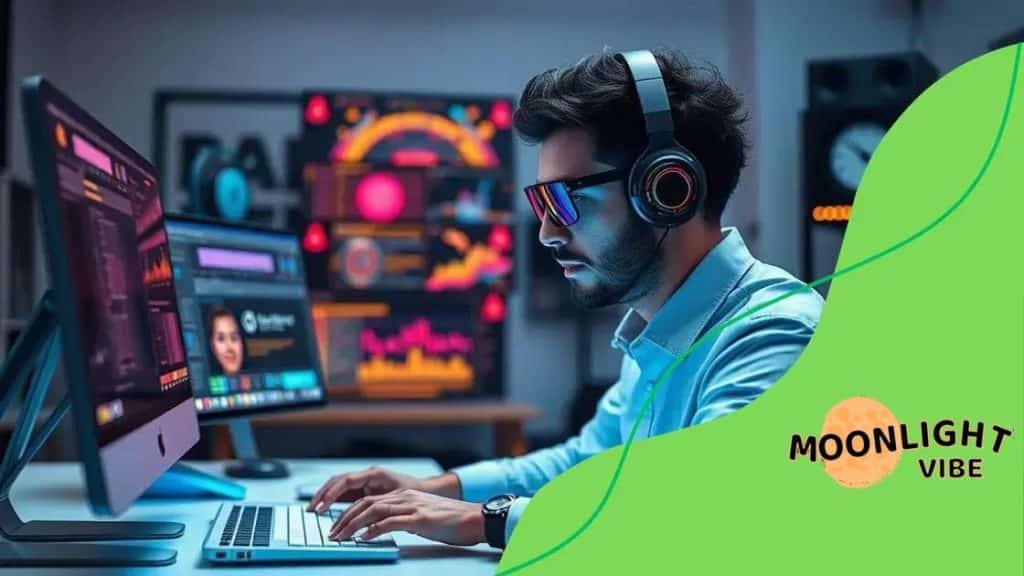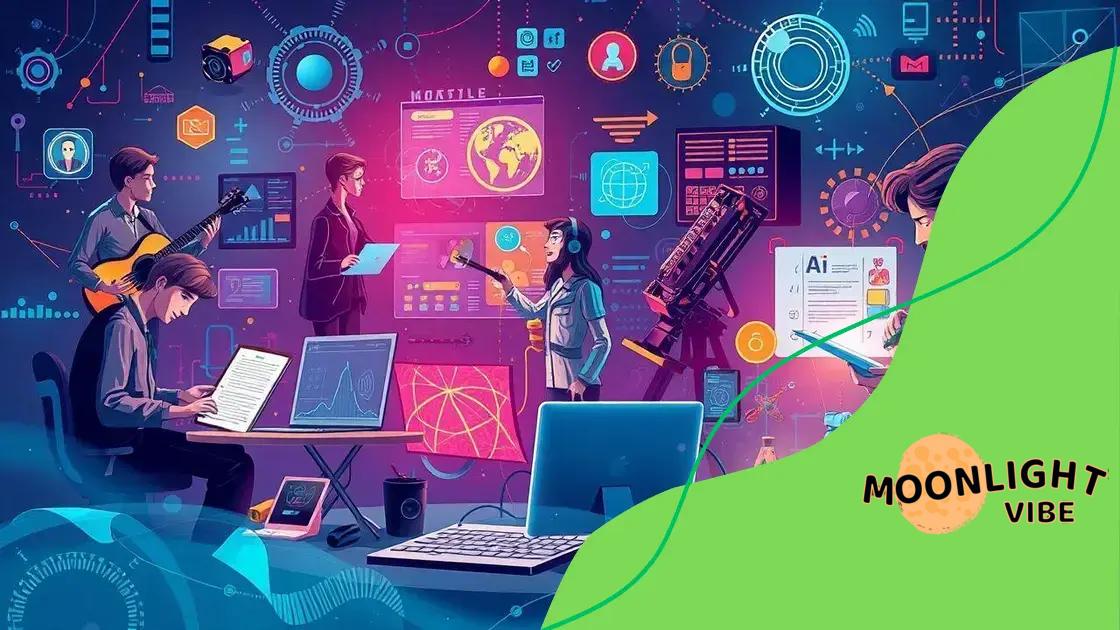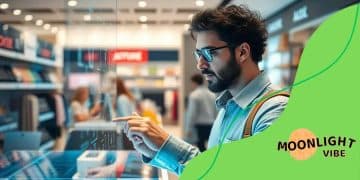The role of AI in transforming the creative industries

Anúncios
The role of AI in transforming the creative industries involves enhancing artistic expression, enabling collaboration, and raising ethical concerns, while shaping future trends in personalized experiences and creative output.
The role of AI in transforming the creative industries is reshaping how artists, designers, and creators engage with their work. Have you ever wondered how technology can amplify creativity and push boundaries? Let’s dive in.
Anúncios
Introduction to AI in creative industries
As technology advances, we see that AI is beginning to play a pivotal role in the creative industries. This transformation is not just about automation; it’s about enhancing the very essence of creativity.
Understanding AI
AI, or Artificial Intelligence, utilizes algorithms to perform tasks typically requiring human intelligence. In the context of creative industries, this can mean everything from generating new art to crafting unique stories. How does it work? By analyzing vast amounts of data, AI can identify patterns and generate ideas that may not be immediately apparent to human creators.
Applications in the Creative Sector
AI applications are diverse and can be found in various creative fields:
Anúncios
- In music production, AI tools can help compose melodies or suggest chord progressions.
- For graphic design, AI can create logos and layouts based on user preferences.
- In writing, AI can aid authors by providing prompts or even drafting entire scenes.
- In film, AI technologies can analyze scripts to predict audience engagement.
The integration of AI into these fields is allowing artists and creators to push boundaries further than ever before. For instance, generative art—a method where AI creates visual art by learning from existing pieces—has emerged as a fascinating area of exploration. Artists are now collaborating with AI to generate works that reflect human creativity and machine ingenuity.
However, as we embrace these technological advancements, we also need to consider the ethical implications. What does it mean for original work? How do we credit AI contributions? These questions become increasingly important as AI continues to evolve and influence the landscape of creative industries.
How AI enhances artistic expression
AI is not just a tool; it is transforming how artists express themselves. By providing new ways to create and innovate, AI enhances artistic expression on multiple levels.
New Tools for Creation
With AI, artists have access to advanced tools that can generate music, visuals, and even dance choreography. These tools can assist in the creative process, offering suggestions based on the artist’s style. For example, AI programs can analyze existing artworks and create variations that inspire artists or help them discover new directions.
Collaboration Between Human and Machine
One exciting aspect of AI in art is the collaboration between humans and machines. Artists can work alongside AI to produce unique pieces that combine the best of both worlds. This fusion can result in artwork that is more innovative and pushes traditional boundaries. Some artists are even using AI to remix and reimagine existing works, creating something entirely fresh.
- AI can help create original scores for films or projects.
- Visual artists use AI to incorporate dynamic elements into their pieces.
- In writing, AI can generate poetry or assist with story development.
- AI tools can personalize experiences in interactive installations.
This integration of AI not only broadens the scope of what is possible in the arts, but it also invites audiences to engage with art in new ways. Interactive installations powered by AI can respond to viewers, making each experience unique. Furthermore, this can blur the lines between artist and audience, allowing for a more participatory culture.
However, while embracing these enhancements, it’s essential for artists to consider the authenticity of their voice. AI can assist but should not overshadow the critical human element in art. This balance is vital as artists continue to explore new frontiers in artistic expression.
Real-world applications of AI in creative sectors

AI is making significant strides in various creative sectors, leading to exciting innovations and new possibilities. These real-world applications of AI are transforming industries like music, art, design, and writing.
Music Industry
In the music industry, AI is being used to compose songs, analyze trends, and even produce tracks. Some platforms can generate original compositions based on specific styles, allowing artists to explore new musical landscapes.
Visual Arts
For visual artists, AI tools can help create stunning artwork. Programs can analyze existing styles and generate new pieces that reflect those influences. Artists can use these tools to enhance their creativity and push their artistic boundaries.
- AI can generate design prototypes for logos and branding.
- Interactive installations use AI to respond to viewer movements and emotions.
- Visual storytelling is enhanced with AI-generated imagery.
- Photography can benefit from AI in editing and enhancing images.
In the film industry, AI assists with script analysis, predicting audience engagement, and even creating storyboards. This technology aids producers in making informed decisions about content that resonates with viewers. AI’s ability to sift through large datasets allows filmmakers to identify winning elements that contribute to successful films.
Writers are also embracing AI. Tools that generate content or suggest plot twists can be invaluable to authors facing writer’s block. These writing assistants can help craft engaging narratives by providing fresh ideas and new angles.
The impact of AI in creative sectors is undeniable. It not only boosts productivity but also reshapes how creators think about their work. As AI technologies become more integrated into these industries, they foster unique collaborations between humans and machines, enriching the creative process.
Challenges and ethical considerations
As AI continues to grow in creative industries, it presents numerous challenges and raises important ethical considerations. Addressing these issues is vital for ensuring that technology enhances rather than hinders creativity.
Job Displacement
One major concern is the potential for job displacement as AI automates tasks traditionally performed by humans. While AI can increase efficiency, it may also replace jobs in fields such as graphic design, content creation, and even music composition. This shift prompts questions about the future workforce and how professionals can adapt in an evolving job market.
Intellectual Property Issues
Another significant challenge revolves around intellectual property. When AI creates original works, who owns the copyrights? Is it the programmer, the user, or the AI itself? These questions remain largely unanswered and are critical for artists and creators.
- Ensuring fair attribution of work generated with AI assistance.
- Establishing clear guidelines on copyright ownership.
- Protecting artists from unauthorized use of their styles by AI.
- Addressing the quality and authenticity of AI-generated content.
Moreover, ethical concerns about bias in AI algorithms merit attention. If AI systems are trained on biased data, they may reproduce or even amplify these biases in creative works. This can lead to representations that are not only inaccurate but also harmful. It is essential for developers to remain aware of these issues during the design and training of AI models.
Furthermore, the potential for AI to create deepfakes or manipulate media raises concerns about misinformation and trust in creative content. The line between true and false can blur, making it difficult for audiences to discern the authenticity of what they consume. Artists and technologists must work together to navigate these challenges responsibly.
Future trends of AI in creativity
The future of AI in creativity is full of exciting possibilities and innovations. As technology advances, we can expect AI to play an even more significant role in various artistic fields.
Personalized Creative Experiences
One emerging trend is the ability for AI to create highly personalized content. Imagine a system that tailors music or art suggestions specifically for you, based on your preferences and emotional responses. This could lead to more engaging experiences for audiences and even more meaningful connections between creators and their audiences.
Collaboration Between Humans and AI
Collaboration will be another key aspect of the future landscape. As AI tools become more sophisticated, artists will collaborate with these technologies to create innovative works. This partnership can help push the boundaries of creativity, allowing for unique expressions that blend human intuition with AI’s capabilities.
- Development of AI tools that learn and adapt to individual artistic styles.
- AI-driven platforms for collaborative projects between artists and AI.
- Integration of AI into live performances and interactive exhibits.
- Exploration of ethical design practices in AI art generation.
We will also see AI assist in idea generation and concept development. By analyzing vast amounts of data, AI can provide unique insights that inspire creators to explore new directions in their work. This could result in fresh narratives and artistic styles that were previously unimagined.
Furthermore, advancements in AI technology may lead to the rise of entirely new art forms. With generative art becoming more prevalent, it is likely that artists will increasingly use AI to craft immersive environments and experiences that engage multiple senses.
Finally, as AI continues to evolve, the conversation around ethics and responsibility will also shape its future in creativity. A focus on creating transparent and fair AI systems will become crucial as artists navigate the balance between human creativity and technological assistance.
FAQ – Frequently Asked Questions about the Role of AI in Creativity
How does AI enhance artistic expression?
AI enhances artistic expression by providing new tools and ideas, allowing artists to explore innovative styles and collaborate with technology.
What are the ethical concerns regarding AI in creative fields?
Concerns include job displacement, intellectual property rights, and bias in AI algorithms, which can impact the authenticity and ownership of art.
How can artists and AI collaborate effectively?
Artists can use AI tools to supplement their creativity, generating new ideas or elements that they can refine and adapt in their work.
What future trends should we expect with AI in the creative sector?
Future trends may include personalized creative experiences, deeper collaborative efforts between humans and AI, and the emergence of new art forms driven by technology.





